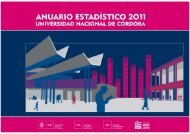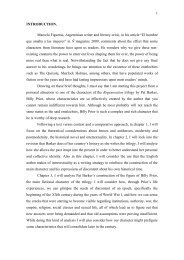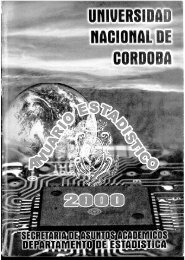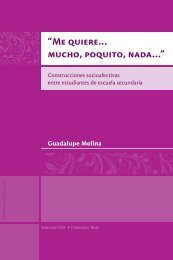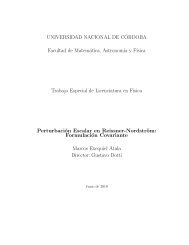Abrir - RDU - Universidad Nacional de Córdoba
Abrir - RDU - Universidad Nacional de Córdoba
Abrir - RDU - Universidad Nacional de Córdoba
Create successful ePaper yourself
Turn your PDF publications into a flip-book with our unique Google optimized e-Paper software.
4.2. COCIENTES DE O ɛ (G) DE DIMENSIÓN FINITA 61<br />
Observación 4.2.19. Las álgebras <strong>de</strong> Hopf A σ = O ɛ (G)/(J ) no sólo <strong>de</strong>pen<strong>de</strong>n <strong>de</strong> σ sino también<br />
<strong>de</strong> g y la raíz <strong>de</strong> la unidad ɛ. Sin embargo, estos datos son invariantes con respecto a la primera<br />
construcción: si A σ,ɛ,g ≃ A σ ′ ,ɛ ′ ,g ′ entonces ɛ = ɛ′ , g ≃ g ′ y Γ ≃ Γ ′ . A saber, <strong>de</strong>notemos por ϕ :<br />
A σ,ɛ,g → A σ ′ ,ɛ ′ ,g ′ el isomorfismo. Como Z(u ɛ(g) ∗ ) = Z(u ɛ ′(g ′ ) ∗ ) = C, por el Lema 2.3.13 tenemos<br />
que Z(A σ,ɛ,g ) = C Γ y Z(A σ ′ ,ɛ ′ ,g ′) = CΓ′ . Así, por la Proposición 2.3.12, ϕ induce dos isomorfismo<br />
ϕ : C Γ → C Γ′ y ϕ : u ɛ (g) ∗ → u ɛ ′(g ′ ) ∗ . En particular se tiene que Γ ≃ Γ ′ y u ɛ (g) ≃ u ɛ ′(g ′ ). Puesto<br />
que los núcleos <strong>de</strong> Frobenius-Lusztig son espacios lineales cuánticos <strong>de</strong> tipo Cartan, <strong>de</strong> [AS5, Thm.<br />
7.2] se sigue que ɛ = ɛ ′ y g ≃ g ′ .<br />
Más a<strong>de</strong>lante en esta tesis notaremos A ɛ,g,σ = A σ para enfatizar la <strong>de</strong>pen<strong>de</strong>ncia en la terna.<br />
Recordar que, por la Definición 4.2.9, dos inclusiones σ 1 y σ 2 son equivalentes si existe una terna<br />
(τ, f, v) don<strong>de</strong><br />
(i) τ ∈ Aut(Γ),<br />
(ii) f ∈ qAut(G) y<br />
(iii) v ∈ Z 1 f,σ 2<br />
(Γ, G) con v(1) = 1.<br />
Si aplicamos el Teorema 2.3.15 a las extensiones A 1 y A 1 obtenemos lo siguiente.<br />
Teorema 4.2.20. Si las álgebras <strong>de</strong> Hopf A 1 y A 2 son isomorfas entonces σ 1 ∼ σ 2 a través <strong>de</strong><br />
una terna (τ, f, v) con v ∈ Z 1 f,σ 2<br />
(Γ, T fσ 2<br />
).<br />
Demostración. Por el Teorema 2.3.15, sabemos que las álgebras <strong>de</strong> Hopf A 1 y A 2 son isomorfas<br />
si y sólo si existe una terna (ω, g, u) tal que ω ∈ Aut(C Γ ), g ∈ qAut(O(G)) y u ∈ Reg 1,ε (O ɛ (G), C Γ )<br />
es un morfismo <strong>de</strong> álgebras que satisface las propieda<strong>de</strong>s (2.12) y (2.13). Las transpuestas <strong>de</strong> estas<br />
aplicaciones inducen las aplicaciones t ω = τ ∈ Aut(Γ), t g = f ∈ qAut(G) y t u = µ ∈ Map(Γ, G ɛ ),<br />
don<strong>de</strong> G ɛ = Alg(O ɛ (G), C) y µ(1) = 1.<br />
Sea v = t ιµ, entonces v es un 1-cociclo que satisface (iii): por la Subsección 4.1.2, la imagen <strong>de</strong><br />
t ι : G ɛ → G es el toro maximal T, entonces la composición v = t ιµ es una función v : Γ → T ⊂ G,<br />
que por las ecuaciones (2.12) y (2.13) satisface que<br />
σ 1 (τ(x)) = f(σ 2 (x))v(x) y v(xy) = f(σ 2 (y)) −1 v(x)σ 1 (τ(y))<br />
= f(σ 2 (y)) −1 v(x)f(σ 2 (y))v(y)<br />
= (v(x) ↼ y)v(y).<br />
para todo g, h ∈ Γ. En efecto, para todo x, y ∈ Γ y b ∈ O(G) tenemos que<br />
< σ 1 (τ(x)), b > =< t p 1 ( t ω(x)), b >=< t (ωp 1 )(x), b >=< x, ωp 1 (b) ><br />
=< x, p 2 g(b (1) )uι(b (2) ) >=< x, p 2 g(b (1) ) >< x, uι(b (2) ) ><br />
=< t (p 2 g)(x), b (1) >< t (uι)(x), b (2) >=< t g( t p 2 (x)), b (1) >< t ι( t u(x)), b (2) ><br />
=< f(σ 2 (x)), b (1) >< v(x), b (2) >=< f(σ 2 (x))v(x), b >,



